Hear “Arkansas,” and you probably think of Bill Clinton. Maybe you think of Maya Angelou. Or the Delta Blues and musicians like Al Green, Glen Campbell, Johnny Cash, and The Band’s Levon Helm. Maybe you think of salt-of-the-earth cotton and soybean farmers toiling underneath the hot sun. Or perhaps you think of the Little Rock Nine integrating with a formerly all-white school. That’s the thing about a trip to Arkansas: you can’t define it in just one image, sentence, or event. It’s constantly evolving and surprising you. And the only way to begin understanding The Natural State is to see it yourself. Here are ten destinations that should be on your Arkansas bucket list.
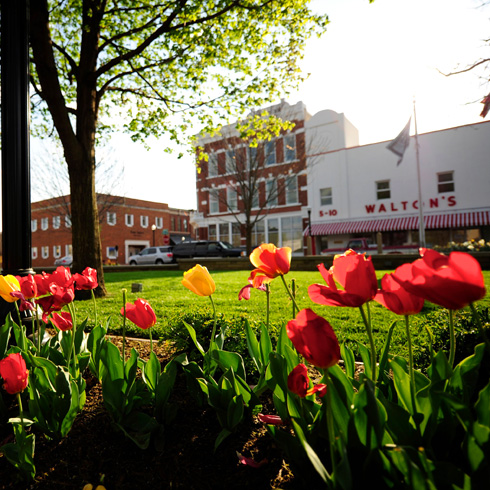
1. Bentonville
Bentonville isn’t the largest city in Arkansas, but it’s one of the most famous. This is where Sam Walton opened Walton’s 5 and 10 which would later become Walmart. Visit the Walmart Museum next to the original five-and-dime on the town square to learn the story of the world’s largest retailer.
In recent years, Bentonville has become a must-visit destination for arts and outdoor adventure. Be sure to visit the Moshe Safdie-designed Crystal Bridges Museum of American Art, boasting a collection that includes works by, among others, Norman Rockwell, Jasper Johns, Andrew Wyeth, and Jackson Pollock. Don’t miss out on the Momentary, a contemporary art space for visual, performing, and culinary arts that occupies a decommissioned cheese factory. Want to spend time in nature? A trail network of over 40 miles connects Bentonville’s parks and scenic spots, including Coler Mountain Bike Preserve. It’s not for nothing that Bentonville calls itself the Mountain Biking Capital of the World.
And that’s just the beginning. Explore the Museum of Native American History, Thaden Field, Osage Park and the Scott Family Amazeum, an interactive children’s museum, as-well-as a vareity of local shops and must try culinary delights throughout the city.
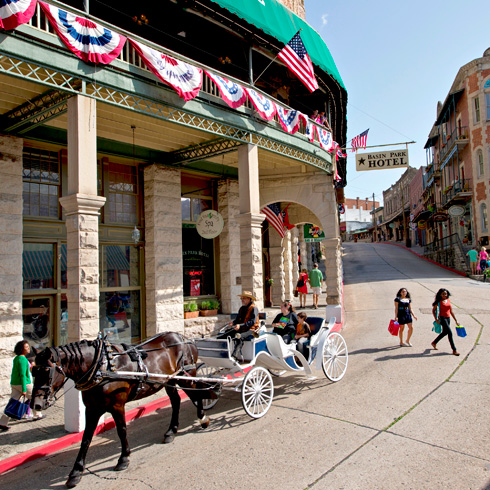
2. Eureka Springs
Unlike the towns and cities on the flatlands of the Arkansas Delta, Eureka Springs in the Ozark Mountains has streets so steep that it’s been nicknamed the “Stairstep Town.” Luckily there is no shortage of spa and massage services in town to soothe muscles sore from navigating the mountainous terrain. At one stage, it was such a popular Victorian resort town that it was the second most populous city in the state. After all, Eureka Springs was founded on the legend that its spring waters have healing powers.
Today Eureka Springs is a haven for artists, free spirits and the LGBTQ+ community. The attractions here aren’t run-of-the-mill either: ghost hunting in a hotel dating from 1905; an underground lake complete with trout; a passion play that’s performed throughout the year; a non-denomination chapel built from organic materials, flat stone and 425 windows; treehouses and hobbit caves to stay in – all under the watchful eye of the gigantic Christ of the Ozarks statue.
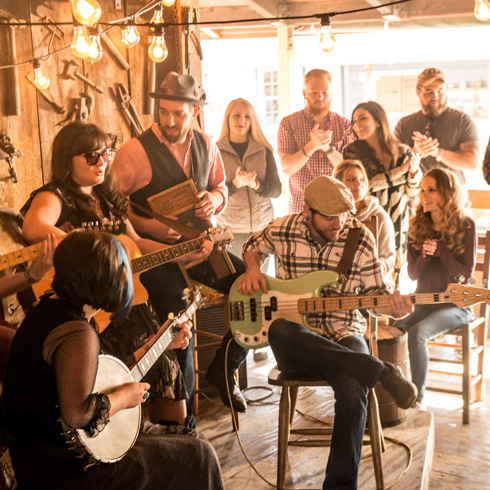
3. Mountain View
According to the old folk song, an Arkansas traveller sought shelter from the rain with an old man who was happily fiddling while the water streamed into his cabin, which he insisted never leaked when it wasn’t raining. That old man could have lived in Mountain View: the “Folk Music Capital of the World,” as the locals call it. Folk music takes centre stage here during events like the Arkansas Folk Festival. From April to October, the Ozark Folk Center State Park brings the history and traditions of the Ozarks to life, with artisans showing the tricks of their trades to the soundtrack of live folk music shows. The area around Mountain View offers outdoor pursuits like trout fishing, hiking, mountain biking and camping. You can also attend workshops in the herb garden to learn more about herbs and medicinal plants to grow. If you need an adrenaline rush, there are treetop adventures too.
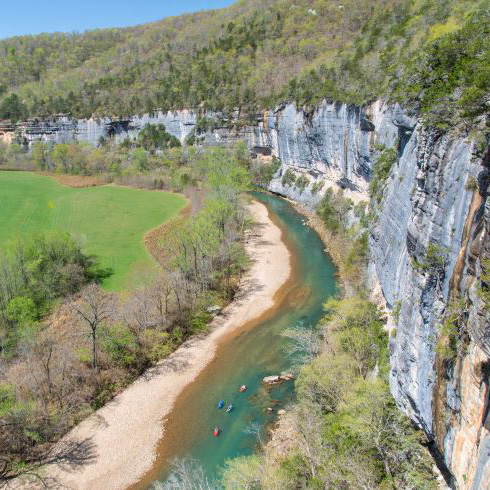
4. Ponca
The tiny community of Ponca makes for the perfect base from which to explore the Buffalo National River. This river has a birthday this year: 50 years ago, in 1972, an Act of Congress made it the first river in the United States to be designated a national river, giving it special protection. Ponca is a popular place to go hiking, fishing, canoeing and spotting elk in the Boxley Valley.

5. The Ozarks
When Jason Bateman’s Marty Byrde decides to launder money in the middle of nowhere to save his skin, he moves his family to the Ozarks. While the specific spot in Ozark is located in Missouri, Northwestern Arkansas sees some of the highest peaks in the Ozark Mountains. Plenty of lakes were created when the area’s rivers were dammed. This makes for spectacular scenery and plenty of outdoor pursuits, with quaint mountain villages providing some civilization. Want to walk away from it all, though? The Ozark Highlands Trail is the ultimate hike in the state. It stretches over 351 km from Lake Fort Smith State Park to the Buffalo National River, traversing the Ozark National Forest. The Ozarks are especially photogenic in the fall when the trees are adorned in their finest reds, yellows and oranges.
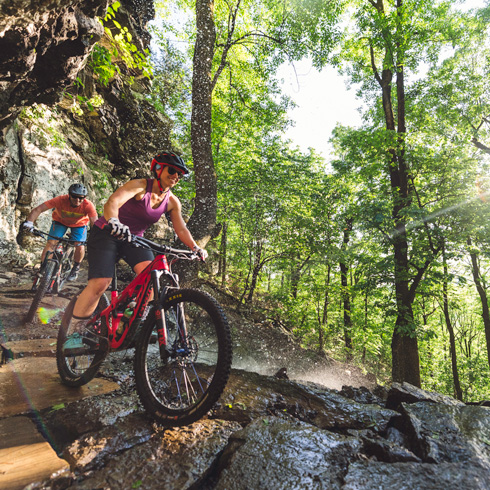
6. Mount Nebo State Park
Lake Dardanelle is about halfway between Little Rock and Fort Smith. Overlooking this lake in the Arkansas River Valley is flat-topped Mount Nebo, where Mount Nebo State Park is located.
As a certified Trail of Tears National Historic Trail site, Mount Nebo witnessed the arduous journey of the Cherokee, Choctaw, Creek, Seminole and Chickasaw people after their forced removal from their ancestral lands in the 1830s. A century later, it also witnessed the work of the Civilian Conservation Corps, created to provide jobs for men left destitute after the Great Depression. In fact, you can stay in one of the rustic cabins they built here along the bluff if you don’t feel like camping. The park is part of the Monument Trails mountain-biking network with two bike-only trails and seven other trails suitable for hiking and simply enjoying the views.

7. Little Rock
Little Rock, Arkansas, is not only the state’s largest city but also its capital and economic and cultural hub. Here, on the south bank of the Arkansas River, you’ll find the William J. Clinton Presidential Library and Museum, where you can see an exact replica of the Oval Office and peruse memorabilia from Clinton’s life in the West Wing. The Arkansas Governor’s Mansion may look surprisingly familiar: Back when the Clintons lived here, the producers used footage of the mansion for the home of Delta Burke’s character, Suzanne Sugarbaker, in Designing Women.
The city is also home to several museums and historic sites that help provide insight into what shaped Bill Clinton’s views. Stroll west along the riverbank from the Presidential Library to the Vogel Schwartz Sculpture Garden in Riverfront Park. This is one of the stops along the Arkansas River Trail, which crosses the river via the Big Dam Bridge, the longest pedestrian and bicycle bridge in North America that has never been used by trains or vehicles. The trail then loops back to cross the river again via the Junction Bridge, at the end of which you’ll find the rocky outcrop that gave the city its name. Of course, you need fuel for all that exploring and Little Rock is home to a wide variety of excellent local dining experiences. Arkansan dishes you must try in Little Rock restaurants include cheese dip, fried catfish and possum pie, which doesn’t contain any possums. Phew!
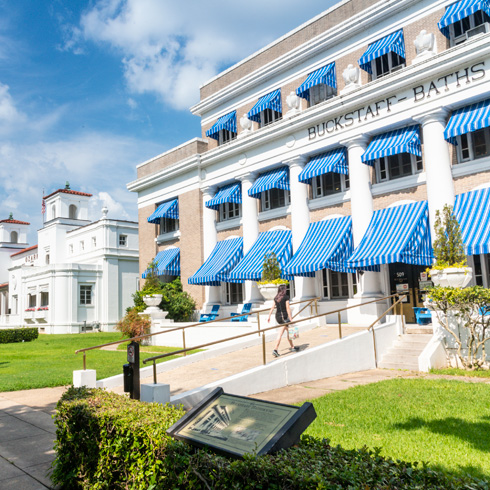
8. Hot Springs
Just about every state in the Union has a Hot Springs. Hot Springs, Arkansas, on the banks of the Ouachita River, seems to have attracted quite a few famous men in its history. Billy Bob Thornton was born here, Bill Clinton lived here as a boy, and Al Capone loved staying at the Arlington Hotel on Bathhouse Row. Bathhouse Row dates from the 1830s and is part of what is now Hot Springs National Park. As the name implies, it’s a collection of bathhouses dating from different eras. In this part of town, you’ll also find the Gangster Museum of America, which tells you about the city’s chequered past.
Today’s Hot Springs is a trove of architectural treasures and trails to explore. If you want the excitement without the effort, spend the day at the races at the Oaklawn Racing Casino Resort or, even better, get hitched: Hot Springs hotels even offer elopement packages.
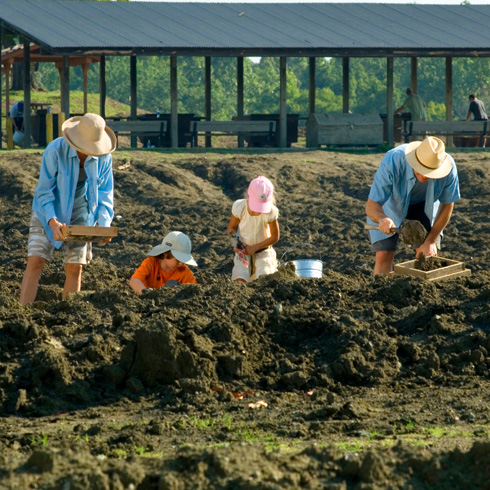
9. Murfreesboro
Murfreesboro in southwest Arkansas is just the place for you if you like to get your hands dirty. And no, we don’t mean creating a rock garden, although we are talking about rocks. One of Murfreesboro’s most popular attractions is Crater of Diamonds State Park, just south of the city. Here, visitors can dig for diamonds and other stones, like agate, amethyst, jasper, quartz and garnet. It’s finders keepers, too! Whatever you dig up, no matter how much it’s worth, is yours to take home. After digging and exploring, you’ll want to wash off all that grime. What better place to do it than Diamond Springs Water Park?
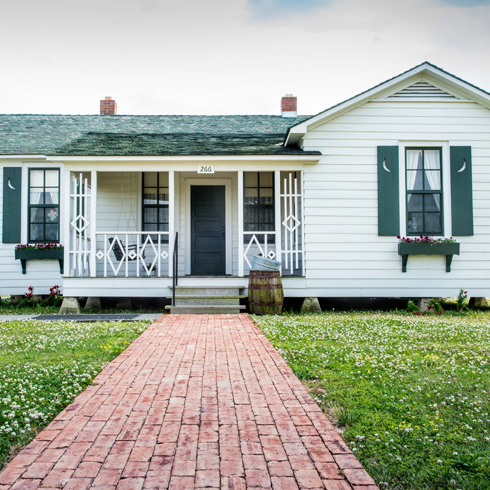
10. Wilson/Dyess
In the northeastern corner of Arkansas, near the Mississippi River and the border with Tennessee, lies the city of Wilson, population 766 at last count. This is a cotton-growing country, but it doesn’t mean a visit will leave you with the cotton-pickin’ blues. One of the first things you’ll notice is that Wilson looks like it could date from Elizabethan times. That’s because the son of Robert E. Lee Wilson, the city’s founder, and his bride returned from their honeymoon in England in 1925 and decided that all buildings in what was then still a company town should be in the Tudor architectural style. Today, the town square is where it’s at, with interesting stores like White’s Mercantile to shop at before lunch at the Wilson Café and Tavern.
If you like to learn, you’ll love the gardening workshops and classes at The Grange, covering everything from essential gardening tips to flower arranging. You can learn more about the area at the Hampson Archaeological Museum State Park. The Wilson Music Series showcases musicians from all over and in all genres. It’s no surprise that music is important in these parts. About 15 minutes drive to the west is the town of Dyess, founded in 1934 as a New Deal colony to give low-income families a place to live and work. One of these was the Cash family, who moved here when their fourth child, Johnny, was three years old. Today, you can visit the Johnny Cash Boyhood Home and see where the future Man in Black worked in his father’s cotton fields as a five-year-old.
HGTV your inbox.
By clicking "SIGN UP” you agree to receive emails from HGTV and accept Corus' Terms of Use and Corus' Privacy Policy.




